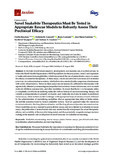Mostrar el registro sencillo del ítem
Novel snakebite therapeutics must be tested in appropriate rescue models to robustly assess their preclinical efficacy
| dc.creator | Knudsen, Cecilie | |
| dc.creator | Casewell, Nicholas R. | |
| dc.creator | Lomonte, Bruno | |
| dc.creator | Gutiérrez, José María | |
| dc.creator | Vaiyapuri, Sakthivel | |
| dc.creator | Laustsen, Andreas Hougaard | |
| dc.date.accessioned | 2021-04-05T21:17:16Z | |
| dc.date.available | 2021-04-05T21:17:16Z | |
| dc.date.issued | 2020 | |
| dc.identifier.citation | https://www.mdpi.com/2072-6651/12/9/528 | |
| dc.identifier.issn | 2072-6651 | |
| dc.identifier.uri | https://hdl.handle.net/10669/83163 | |
| dc.description.abstract | In the field of antivenom research, development, and manufacture, it is often advised to follow the World Health Organization’s (WHO) guidelines for the production, control, and regulation of snake antivenom immunoglobulins, which recommend the use of preincubation assays to assess the efficacy of snakebite therapeutics. In these assays, venom and antivenom are mixed and incubated prior to in vivo administration to rodents, which allows for a standardizable comparison of antivenoms with similar characteristics. However, these assays are not necessarily sufficient for therapeutics with significantly different pharmacological properties than antibody-based antivenoms, such as small molecule inhibitors, nanoparticles, and other modalities. To ensure that the in vivo therapeutic utility of completely novel toxin-neutralizing molecules with no history of use in envenoming therapy and variable pharmacokinetics is properly evaluated, such molecules must also be tested in preclinical rescue assays, where rodents are first challenged with appropriate doses of venoms or toxins, followed by the administration of neutralizing modalities after an appropriate time delay to better mimic the real-life scenarios faced by human snakebite victims. Such an approach takes the venom (or toxin) toxicokinetics, the drug pharmacokinetics, and the drug pharmacodynamics into consideration. If new modalities are only assessed in preincubation assays and not subjected to evaluation in rescue assays, the publication of neutralization data may unintentionally misrepresent the actual therapeutic efficacy and suitability of the modality being tested, and thus potentially misguide strategic decision making in the research and development of novel therapies for snakebite envenoming | es_ES |
| dc.description.sponsorship | Villum Foundation/[Project 00025302]//Dinamarca | es_ES |
| dc.description.sponsorship | BioPorto Diagnostics A/S/[]//Dinamarca | es_ES |
| dc.language.iso | eng | es_ES |
| dc.source | Toxins, vol.12(9), pp.528 | es_ES |
| dc.subject | Snakebite envenoming | es_ES |
| dc.subject | Rescue assays | es_ES |
| dc.subject | Preincubation assays | es_ES |
| dc.subject | Pre-clinical evaluation | es_ES |
| dc.subject | Toxicokinetics | es_ES |
| dc.subject | Pharmacokinetics | es_ES |
| dc.subject | Envenoming therapy | es_ES |
| dc.title | Novel snakebite therapeutics must be tested in appropriate rescue models to robustly assess their preclinical efficacy | es_ES |
| dc.type | artículo original | |
| dc.identifier.doi | 10.3390/toxins12090528 | |
| dc.description.procedence | UCR::Vicerrectoría de Investigación::Unidades de Investigación::Ciencias de la Salud::Instituto Clodomiro Picado (ICP) | es_ES |
Ficheros en el ítem
Este ítem aparece en la(s) siguiente(s) colección(ones)
-
Microbiología [1171]


